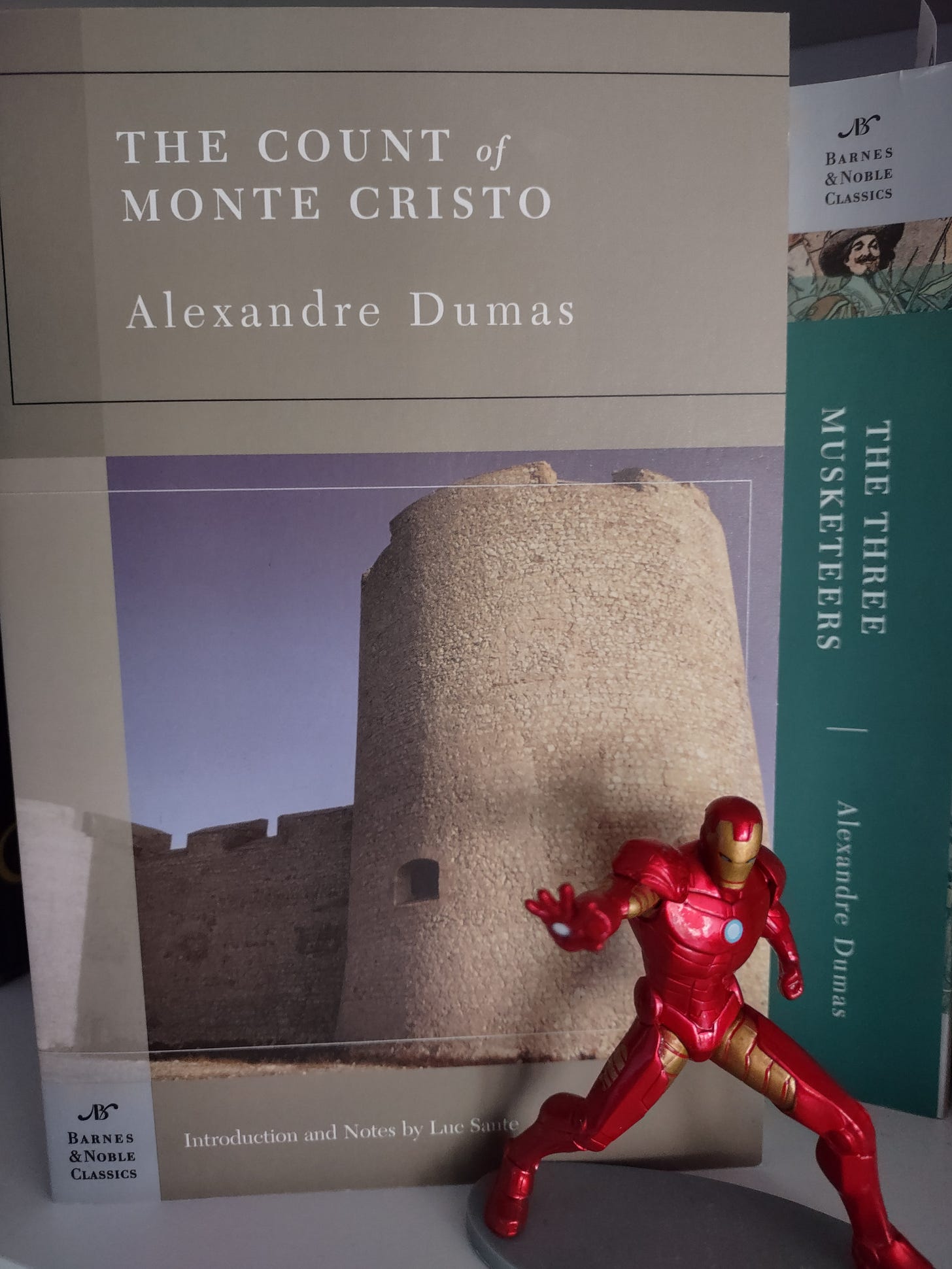Iron Man, The Count of Monte Cristo, and Reinvention
There's always room for improvement.
One of the great things about the Iron Man concept is the idea of personal reinvention—building yourself into something better than you previously were.
And it’s a continuous process. We’ve always got to be working on that next, better suit of armor. Technology is always advancing, and people should advance alongside it.
Iron Man first appeared in Tales of Suspense #39 in 1963, written by Stan Lee and Larry Lieber and drawn by Don Heck, a 12-page origin story that the first movie followed faithfully, updating for modern times with some smart embellishments.
Let’s look at some of the basic elements of that origin story. A man is wrongfully imprisoned and is wasting away in captivity. He befriends an older, wiser prisoner. He learns from this wiser man, and with his help, he builds himself into a better, stronger version of who he was—right under the noses of his captors. The older man eventually must sacrifice his life so the younger man can effect that escape.
Does that remind you of anything? Let’s reach back, all the way to high school English, to The Count of Monte Cristo by Alexandre Dumas.
It’s not an exact parallel; it’s more like an inverse. Edmond Dantes is purely innocent when he’s wrongfully imprisoned. Tony Stark, however, is less pure in the comics and especially less pure in the movie. In both, he’s a very established man who leads a privileged existence, though the movie depicts him as much shallower and more self-involved. He’s developed impressive weapons for the U.S. Army that will come in handy in the current war, whether it’s in Vietnam or the Middle East. And while in that foreign country, the enemy mortally wounds him and captures him. (In the movie, they use his own technology against him, which was a nice revision.)
In confronting death, Tony Stark discovers an opportunity to grow stronger, but he can’t do it without a new mentor, Dr. Yinsen. The movie uses this character much better. Granted, the comic was only twelve pages, so there was only so much they could do. But in the movie in particular, Dr. Yinsen is able to teach Tony, like the Abbe Faria teaches Dantes.
Dantes didn’t have much depth to his education, so he needs Faria to teach him knowledge. Tony already has that. He’s already a genius, so instead, he needs to learn how to have a heart. In both stories, though, the older man gives up his life so the younger man can continue his. It’s a timeless theme—the old teach the young, and the young supplant the old.
In the case of Dantes, his metamorphosis is corrupted by a thirst for vengeance. He detaches from his humanity, especially after the death of his mentor and the only friend he had in prison for all those many years. In Tony Stark’s case, his armor physically separates him from humanity, especially at first, but it also serves as a cocoon in which he learns how to be a better person.
The initial metamorphosis is into something fearsome, unrecognizable, and inhuman—this big ugly gray clunky suit of armor, which is really just the starting point. Tony ends the first issue still in the prototype armor. It’s not even clear whether he’s trapped in it or not. It’s ambiguous and not a conventional superhero ending.
But the armor does the job of allowing him to get out of that prison so he can continue on with his life. In the Iron Man series, both the comic books and the movies, it’s a never-ending process of improving that armor, always building, always fine-tuning, always tinkering, always reaching for that next stage of evolution. Iron Man is always advancing.
Initially, without that big ugly gray clunky suit of armor, Tony Stark would not have survived. It’s a necessary step for his survival. His heart would have failed, like how Dantes would have wasted away in that dungeon if he hadn’t acquired his metaphorical armor of knowledge and, later, wealth.
In both cases, Tony Stark and Edmond Dantes need to rebuild themselves into something better or they’ll die.
The same holds true for Iron Man’s origin story, the details of which needed to be built upon for 2008 to introduce it to a new generation. But here’s the key: The filmmakers respected the excellent foundation that their predecessors laid, and they kept it intact. They refined enough to keep the story alive and flourishing in a new medium and a new era, but they didn’t tamper with its beating heart.
Both Iron Man’s origin story and this portion of The Count of Monte Cristo convey a straightforward message: keep growing, keep learning, and keep evolving—or waste away until you perish.
So on that happy note, read Dumas’s novel, especially if it’s been many years. And read some Iron Man comics, too, while you’re at it.







Another note: Despite the similarities in their stories, the character arcs of Tony Stark and Edmond Dantes are almost diametrically opposite. Edmond begins as an innocent young man whose imprisonment makes him cold, bitter and vengeful. Tony starts as a heartless weapons manufacturer whose experience turns him into a hero. Funny how that works...
"Keep improving, keep changing" is the mantra of Miyoko Sahara in A Silent Voice. It's also the basic philosophy behind the Japanese concept of kaizen ("continual improvement"). And, for what it's worth, it's my own goal as a writer and artist. Thanks for these reminders of the idea from Alexandre Dumas and Stan Lee!